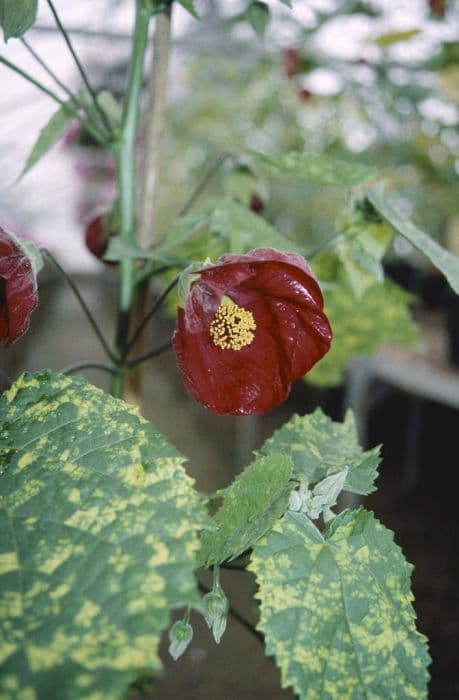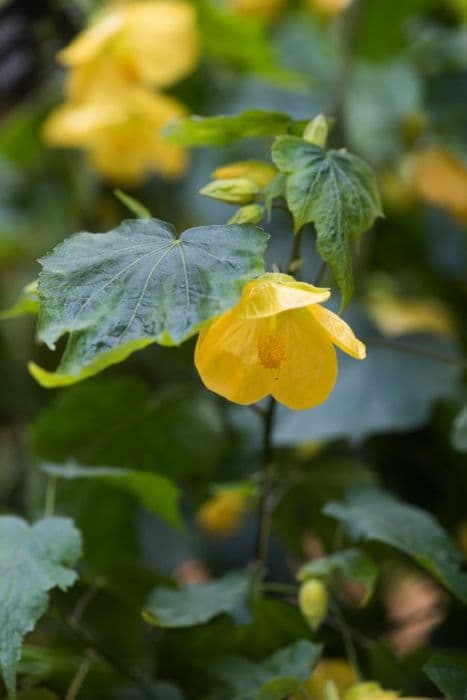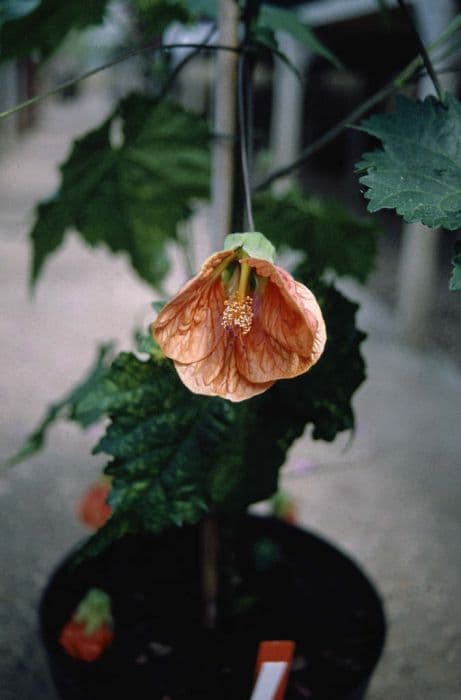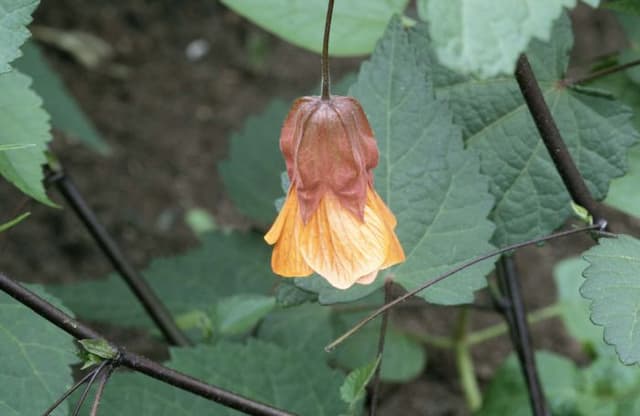Miniature Hollyhock Sidalcea 'Little Princess' (PBR)

ABOUT
The Sidalcea 'Little Princess', commonly known as the checker mallow, boasts a bushy habit with winsome, pink flowers that have a striking resemblance to miniature hollyhocks. The delicate blooms are arranged on upright spikes, presenting a light and airy appearance, which gracefully dances above the foliage with the gentlest breeze. The leaves of the checker mallow are deeply lobed and have a fresh, green color that forms a lush and attractive base for the dainty flower spires. The overall charm of the checker mallow lies in its romantic, cottage garden feel, making it a delightful addition to borders and flower beds where a touch of whimsy and color is desired.
About this plant
 Names
NamesFamily
Malvaceae
Synonyms
Miniature Hollyhock, Dwarf Prairie Mallow, Little Princess Checker Mallow
Common names
Sidalcea 'Little Princess'
 Toxicity
ToxicityTo humans
Sidalcea 'Little Princess', more commonly known as checker mallow, is not widely recognized as a toxic plant to humans. There is limited information on its toxicity, suggesting that it is generally considered safe and does not pose significant risks if ingested. As with all plants, it is advisable to exercise caution and avoid consuming parts of plants not typically recognized as edible, as individual allergic reactions or sensitivities may occur.
To pets
Checker mallow is not known to be toxic to pets. There is limited information on its toxicity, but it is generally considered safe for animals, and there are no well-documented cases of poisoning in pets from ingesting checker mallow. As with all plants, it is still recommended to monitor your pet around plants and discourage them from ingesting plant material, as individual animals may have different sensitivities or allergic reactions.
 Characteristics
CharacteristicsLife cycle
Perennials
Foliage type
Deciduous
Color of leaves
Green
Flower color
Pink
Height
2 feet [60 cm]
Spread
1 foot [30 cm]
Plant type
Herb
Hardiness zones
5
Native area
North America
Benefits
 General Benefits
General Benefits- Attracts Pollinators: Sidalcea 'Little Princess' attracts bees and butterflies, which are essential for pollination.
- Low Maintenance: This plant requires minimal care once established, making it suitable for gardeners of all levels.
- Drought Tolerant: Once established, it can withstand periods of low water, making it ideal for water-conserving gardens.
- Long Blooming Period: It has a long flowering season, providing color and interest in the garden for an extended time.
- Compact Size: The 'Little Princess' variety has a dwarf habit, which is perfect for small spaces or container gardening.
- Decorative Cut Flowers: The flowers look great in bouquets, adding a bright, natural touch to home decor.
- Cold Hardy: It is able to survive and thrive in cooler temperatures, making it suitable for a variety of climates.
- Herbaceous Perennial: As a perennial, it will come back year after year, reducing the need to replant each season.
- Non-Invasive: Its growth habit is well-behaved, reducing the risk of it taking over the garden space.
 Medical Properties
Medical PropertiesThis plant is not used for medical purposes.
 Air-purifying Qualities
Air-purifying QualitiesThis plant is not specifically known for air purifying qualities.
 Other Uses
Other Uses- As a natural fabric dye: The petals of the Sidalcea 'Little Princess' can be used to create dyes for coloring textiles, offering hues ranging from soft pinks to vibrant purples depending on the mordant used.
- In potpourri mixtures: The dried flowers can be included in potpourri blends, adding a light, floral scent and a touch of color to the mix.
- Edible flower garnishes: The flowers of the Sidalcea 'Little Princess' are edible and can be used to decorate desserts or salads, adding a sprinkle of color and a mildly sweet taste.
- Photography subject: Its vibrant blooms and lush foliage make it a popular subject for garden photographers and botanical illustrators.
- Wedding floral arrangements: Due to its delicate appearance, the Sidalcea 'Little Princess' is often used in bridal bouquets and table centerpieces for a romantic touch.
- As a natural confetti: The petals can serve as biodegradable confetti for outdoor celebrations, leaving no harmful residue behind.
- Crafting pressed flowers: Crafters can press the flowers to use in making bookmarks, greeting cards, or framed art due to their vibrant color and interesting texture.
- Teaching tool in horticulture: This plant can be used as an example in educational settings for lessons on plant breeding and cultivar selection due to its patented rights (PBR).
- In butterfly gardens: The Sidalcea 'Little Princess' attracts butterflies, making it a great addition to pollinator-friendly gardens, offering both aesthetic and ecological benefits.
- Floral-scented candles and soaps: Utilize the petals in the production of homemade candles and soaps for a subtle floral fragrance.
Interesting Facts
 Feng Shui
Feng ShuiThe Checkerbloom is not used in Feng Shui practice.
 Zodiac Sign Compitability
Zodiac Sign CompitabilityThe Checkerbloom is not used in astrology practice.
 Plant Symbolism
Plant Symbolism- Femininity: The name 'Little Princess' evokes images of delicacy and grace, often associated with traditional notions of femininity.
- Innocence and Youth: The diminutive 'little' and the term 'princess' together symbolize an innocent, youthful charm that the plant carries through its dainty flowers.
- Charm and Beauty: Sidalcea's showy flowers and attractive growth habit denote a sense of charm and natural beauty, making it a symbol of allure and attractiveness.
- Resilience: While the plant may appear delicate, Sidalcea varieties like 'Little Princess' are quite hardy, representing the strength and resilience that lies within beauty.
 Water
WaterThe Checker Mallow, commonly known as 'Little Princess', should be watered deeply once a week, allowing the soil to dry out slightly between waterings. During the growing season in spring and summer, it may require more frequent watering, especially if the weather is particularly hot or dry. Provide about 1-2 gallons of water per plant each time you water, ensuring that the water penetrates the soil to reach the plant's roots. Reduce watering in the fall and further in the winter when the plant is dormant.
 Light
LightChecker Mallow thrives in full sun to partial shade. It's best to place it in a location where it can receive at least 6 hours of sunlight daily. While it can tolerate some light shade, too much shade can cause the plant to become leggy and produce fewer flowers. A spot with morning sun and afternoon shade can be ideal, especially in hotter climates.
 Temperature
TemperatureChecker Mallow prefers moderate temperatures and can generally survive in temperatures ranging from 20°F to 80°F. The ideal temperature range for 'Little Princess' is between 60°F and 70°F. It's important to protect the plant from frost, which could damage or kill it if exposed to temperatures below 20°F.
 Pruning
PruningPruning of Checker Mallow should be done to remove spent flower spikes and encourage a second bloom. It can also help maintain a tidy plant shape. Prune the 'Little Princess' after the first flush of flowers have faded, typically in midsummer, cutting the flower stalks back to just above a set of leaves. Additionally, remove any dead or damaged growth in the spring.
 Cleaning
CleaningAs needed
 Soil
SoilChecker mallow 'Little Princess' prefers well-drained soil enriched with organic matter, with a neutral to slightly acidic pH of 6.0 to 7.0. A mix containing garden soil, compost, and perlite or sand will ensure good drainage and fertility.
 Repotting
RepottingChecker mallow 'Little Princess' does not require frequent repotting and can be done every 2 to 3 years or when it outgrows its container.
 Humidity & Misting
Humidity & MistingChecker mallow 'Little Princess' tolerates average humidity levels found in most outdoor environments and does not have specific humidity requirements.
 Suitable locations
Suitable locationsIndoor
Place in bright indirect light and ensure good air circulation.
Outdoor
Plant in sun to partial shade with moist, well-drained soil.
Hardiness zone
5-9 USDA
 Life cycle
Life cycleSidalcea 'Little Princess', commonly known as Dwarf Prairie Mallow, starts its life cycle as a seed, usually sown in early spring where it germinates in moist, well-drained soil. After germination, the seedling phase sees rapid growth of foliage and root establishment. Mature plants enter a vegetative stage, characterized by the development of a dense clump of erect, leafy stems. During the flowering stage in midsummer, Dwarf Prairie Mallow produces numerous small, cup-shaped pink flowers on tall, slender spikes, attracting pollinators. After pollination, seeds develop and are eventually dispersed, completing the plant's reproductive cycle. In the fall, the plant begins to die back, entering a period of dormancy over winter, before resuming growth in the subsequent spring from the same root system, as it is a herbaceous perennial.
 Propogation
PropogationPropogation time
Spring-Early Summer
Propogation: Sidalcea 'Little Princess', commonly known as miniature hollyhock, is typically propagated through division, which is the most popular method for this perennial plant. Division is best performed in early spring or autumn. To propagate by division, carefully dig up an established clump of miniature hollyhock and gently separate the root mass into smaller sections, each with a portion of the root system and several shoots. Replant the divisions promptly, spacing them about 12 to 18 inches (approximately 30 to 45 centimeters) apart, at the same depth they were growing previously. Water the new divisions well to help establish them. This process not only propagates the plant but also rejuvenates older clumps that may have become woody or less vigorous, ensuring the continued health and bloom of miniature hollyhocks in the garden.





![Abutilon [Yellow Trumpet]](/_next/image?url=https%3A%2F%2Fplants-admin.emdemapps.com%2Fimages%2Fplants%2F%2Fimages%2F604b5caa8b4fb.png&w=640&q=75)


